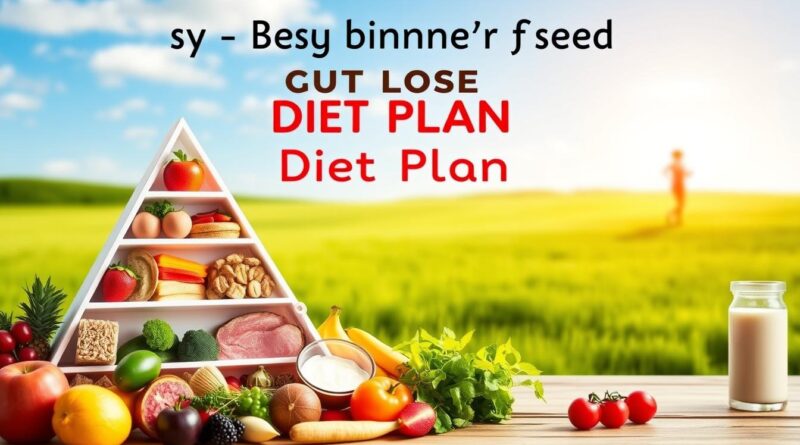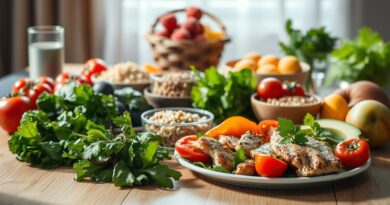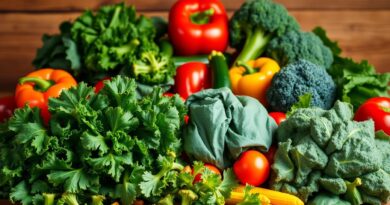Easy Beginner Diet Plan for Effective Weight Loss
Starting a weight loss journey can feel overwhelming. But, a simple and effective diet plan can help you reach your goals. A good beginner diet plan leads to lasting changes in your lifestyle.
Adopting an easy weight loss diet plan can improve your eating habits. It also boosts your energy and overall health. This article will show you a clear path to weight loss. It will give you the tools and motivation to succeed.
Key Takeaways
- A simple diet plan can lead to effective weight loss.
- Sustainable lifestyle changes are key to lasting results.
- A well-structured diet plan helps develop healthy eating habits.
- Increased energy levels and overall well-being are additional benefits.
- A straightforward approach makes it easier to stick to the plan.
Understanding Weight Loss Fundamentals
Starting a weight loss journey can feel overwhelming. But knowing the basics makes it easier. It’s key to understand how the body uses food, the importance of metabolism, and how to eat fewer calories.
The Science Behind Weight Loss
Weight loss is about burning more calories than you eat. This can happen through diet, exercise, and lifestyle changes. Metabolism is crucial because it affects how fast you burn calories. It’s important to eat right, not just cut calories.
Many things affect your metabolism, like age, gender, weight, and how active you are. Knowing these can help you plan your weight loss better.
| Factor | Influence on Metabolism | Actionable Tip |
|---|---|---|
| Age | Metabolic rate slows down with age | Increase physical activity to boost metabolism |
| Gender | Men generally have a higher metabolic rate than women | Tailor calorie intake based on gender-specific needs |
| Weight | More body mass requires more calories to maintain | Focus on losing weight gradually to sustain metabolic health |
| Activity Level | Higher activity levels increase metabolic rate | Engage in regular exercise, including strength training and cardio |
Setting Realistic Expectations and Goals
Setting realistic goals is key for success in weight loss. It’s a slow process, and sustainable changes are better than quick fixes. Goals should be specific, measurable, achievable, relevant, and time-bound (SMART).
For example, losing 1-2 pounds a week is a better goal than trying to lose a lot in a short time. This keeps you motivated and helps you make lasting healthy habits.
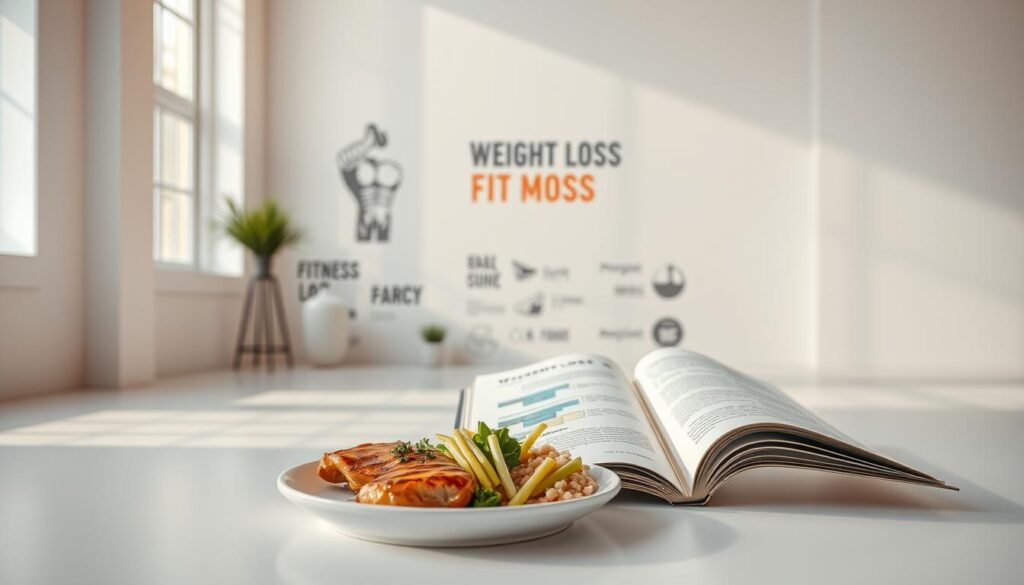
Assessing Your Current Diet and Habits
Knowing what you eat is crucial for changing your diet. It’s important to look at your current eating habits to make a simple diet plan for weight loss. By understanding your daily food choices and patterns, you can make better diet decisions.
Tracking Your Food Intake
Start by tracking what you eat. Use a food diary or a mobile app to log your meals and snacks. Record everything, including portion sizes and the time of day. This will help you notice your eating patterns and find ways to improve.
Identifying Problem Areas
After tracking your food, look for patterns in your eating. Notice if you eat too much at certain times, snack on high-calorie foods, or skip meals. Spotting these patterns is the first step to making better diet choices.
Understanding Your Eating Triggers
Eating triggers are things that make you want to eat. These can be stress, boredom, or being around food. Knowing your triggers helps you manage them. This way, you can follow your beginner weight loss tips and reach your goals.
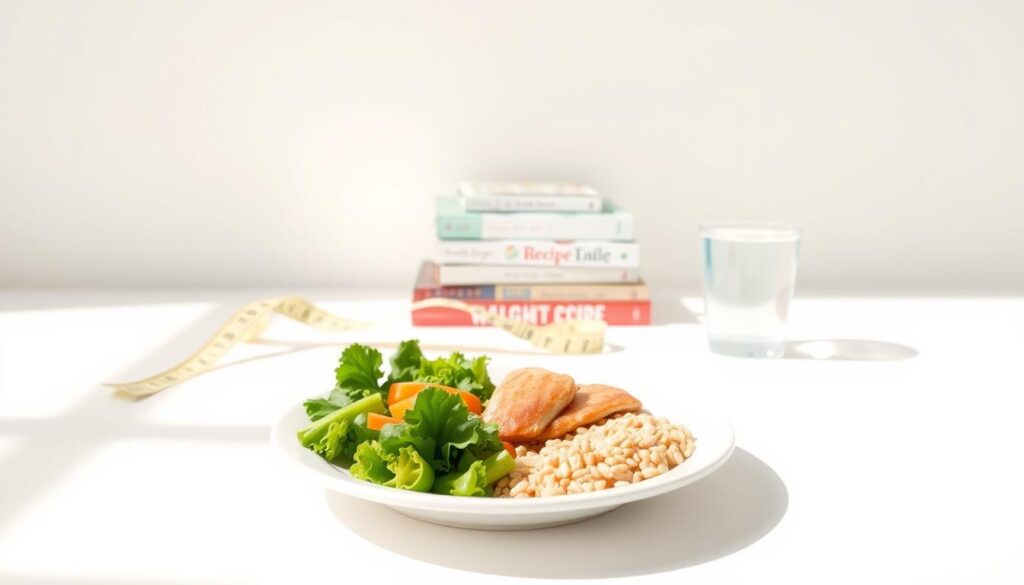
| Eating Habit | Impact on Weight Loss | Improvement Strategy |
|---|---|---|
| Skipping Meals | Can lead to overeating later | Eat regular, balanced meals |
| Consuming High-Calorie Snacks | Hinders weight loss progress | Choose low-calorie, nutrient-rich snacks |
| Eating Out Frequently | Often results in high-calorie intake | Plan meals, cook at home when possible |
Creating Your Beginner Diet Plan for Weight Loss
Starting a weight loss journey needs a diet plan made just for you. A good beginner diet plan for weight loss means knowing how many calories you need each day. It also means balancing carbs, proteins, and fats, and knowing when to eat.
Calculating Your Caloric Needs
To make a beginner weight loss meal plan, first figure out your daily calorie needs. You need to know your basal metabolic rate (BMR) and how active you are. Your BMR is how many calories your body uses when you’re not moving.
Use online BMR calculators to guess your BMR based on your age, gender, weight, and height. Then, adjust your BMR for your activity level. If you’re not very active, you need fewer calories. Aim for a calorie deficit to lose weight without feeling tired.
| Activity Level | Caloric Adjustment |
|---|---|
| Sedentary | BMR x 1.2 |
| Lightly Active | BMR x 1.375 |
| Moderately Active | BMR x 1.55 |
| Very Active | BMR x 1.725 |
| Extra Active | BMR x 1.9 |
Macronutrient Balance for Beginners
A diet for weight loss is more than just cutting calories. It’s also about getting the right mix of carbs, proteins, and fats. Each one is important for your health and losing weight.
For a beginner diet plan for weight loss, aim for 45-65% of your calories from carbs, 15-20% from proteins, and 20-35% from fats. This balance helps with energy, muscle, and hormone health.
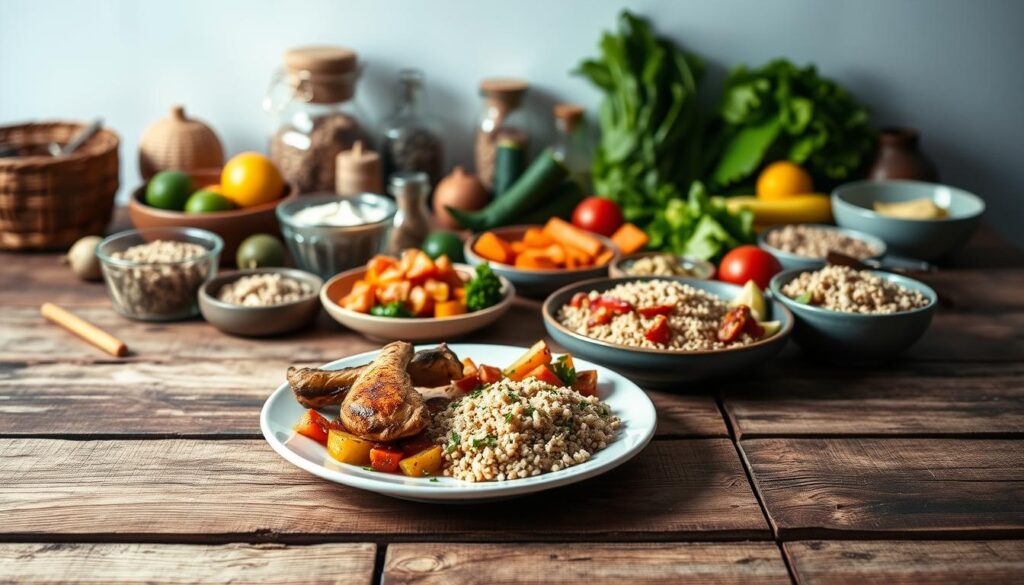
Meal Timing Strategies
Meal timing is key. Find a schedule that works for you and stick to it. Eating smaller meals can help control hunger and boost your metabolism. Listen to your body and eat when you’re hungry, not just on a schedule.
Start with three main meals and one or two snacks in between. Adjust the sizes based on your calorie needs. This flexibility helps keep your beginner weight loss meal plan on track.
Essential Food Groups to Include
Starting a weight loss journey means knowing the key food groups. These foods should be in your daily meals. They give you energy, keep you full, and help your health.
Lean Proteins for Satiety and Muscle Maintenance
Lean proteins are key for keeping muscle while losing weight. They also help you feel full, so you don’t overeat. Good lean proteins are chicken breast, turkey, fish, tofu, and legumes like lentils and chickpeas. Adding lean protein to every meal helps with weight loss.
Complex Carbohydrates for Sustained Energy
Complex carbs give you lasting energy and are full of fiber. They’re a must for a simple diet plan for weight loss. Foods like brown rice, quinoa, whole wheat bread, and oats are great. They help control blood sugar and keep you full longer.
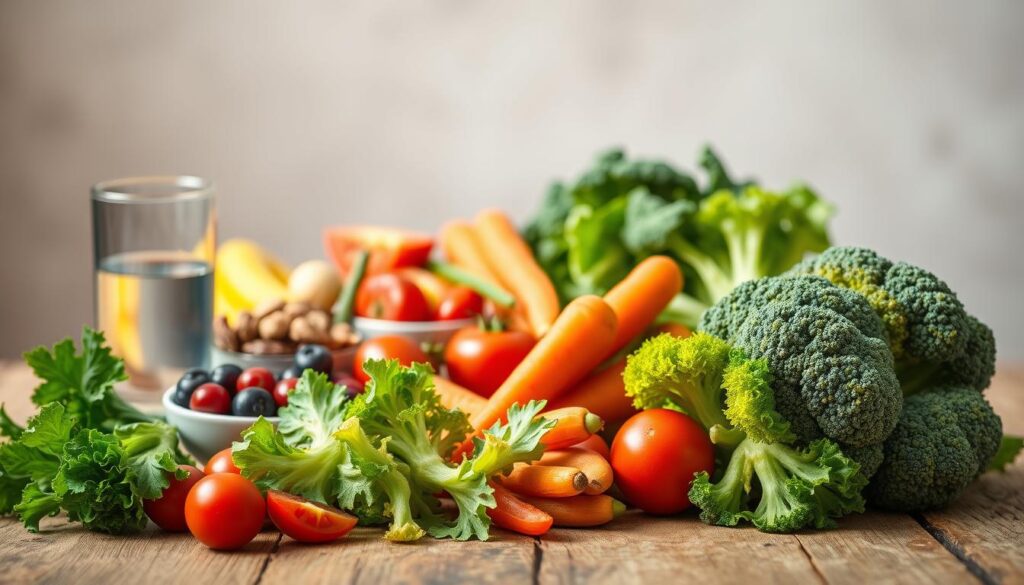
Healthy Fats for Hormone Balance
Healthy fats are important for hormone health and feeling full. Good sources are avocados, nuts, seeds, and olive oil. Adding these to your meals boosts flavor and nutrition.
Fruits and Vegetables for Vital Nutrients
Fruits and veggies are full of vitamins, minerals, and antioxidants. They’re low in calories and high in fiber, making them very filling. Try to have different colors on your plate for a wide range of nutrients.
| Food Group | Examples | Benefits |
|---|---|---|
| Lean Proteins | Chicken breast, fish, tofu, legumes | Satiety, muscle maintenance |
| Complex Carbohydrates | Brown rice, quinoa, whole wheat bread, oats | Sustained energy, fiber |
| Healthy Fats | Avocados, nuts, seeds, olive oil | Hormone balance, satiety |
| Fruits and Vegetables | Variety of colors (leafy greens, berries, citrus fruits) | Vital nutrients, antioxidants |
Adding these food groups to your diet makes a balanced easy weight loss diet plan. It supports your health and well-being.
Foods to Limit or Avoid
A successful beginner weight loss program means more than just adding good foods. It’s also about cutting out the bad ones. Knowing which foods to limit or avoid is key to losing weight.
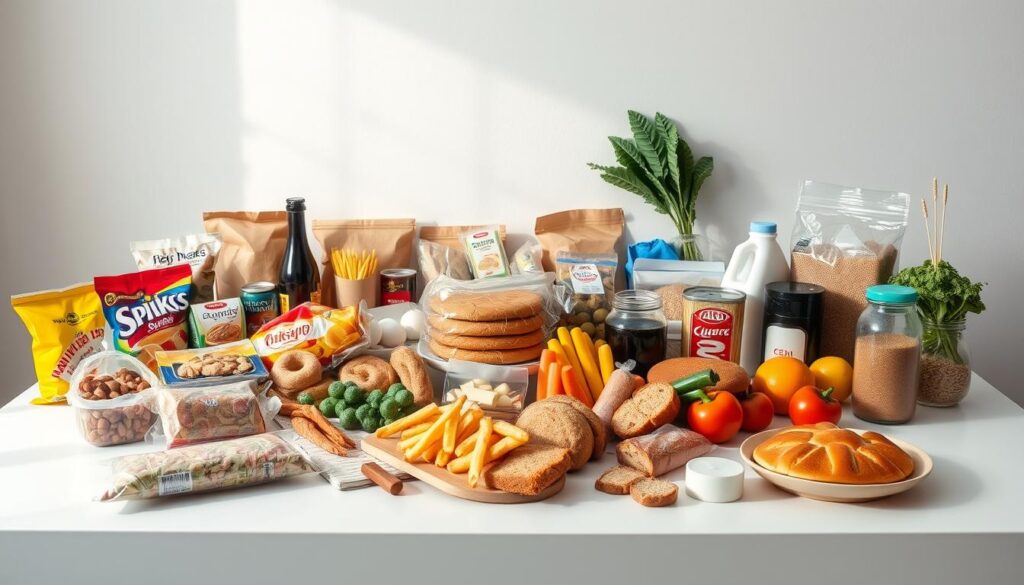
Understanding Processed Foods and Their Alternatives
Processed foods are bad for you because they have unhealthy fats, added sugars, and too much sodium. They can stop you from losing weight. Instead, choose whole foods like veggies, fruits, and lean proteins. For example, pick fresh chicken over processed nuggets.
Hidden Sugars and Their Impact on Weight Loss
Many foods, even healthy ones, have hidden sugars. Too much sugar can slow down your weight loss. Always read the labels to know how much sugar is in your food.
Navigating Restaurant Menus and Social Eating
Eating out or at social events can be tough when you’re trying to lose weight. Plan by looking at menus online. And don’t hesitate to ask for changes to fit your diet. Opt for dishes with lots of veggies and lean proteins to stay on track.
Simple Meal Planning for Beginners
For those starting their weight loss journey, a simple meal plan is key. It guides you towards healthy eating. This way, you can make lasting changes without getting lost in complex diets.
Meal planning is a big step in losing weight. It helps you organize meals, cut down on waste, and save money and time. For newbies, it’s about finding a simple system to follow.
7-Day Sample Meal Plan with Recipes
Starting with a 7-day meal plan is a great way for beginners to begin. Here’s a sample plan with a variety of healthy dishes:
- Monday: Breakfast – Oatmeal with fruits, Lunch – Grilled chicken salad, Dinner – Baked salmon with quinoa
- Tuesday: Breakfast – Scrambled eggs with spinach, Lunch – Turkey and avocado wrap, Dinner – Grilled turkey breast with roasted vegetables
- Wednesday: Breakfast – Greek yogurt with berries, Lunch – Lentil soup, Dinner – Grilled chicken breast with brown rice
- Thursday: Breakfast – Smoothie bowl, Lunch – Grilled chicken Caesar salad, Dinner – Baked chicken thighs with sweet potato
- Friday: Breakfast – Avocado toast, Lunch – Tuna salad sandwich, Dinner – Shrimp and vegetable stir-fry
- Saturday: Breakfast – Overnight oats, Lunch – Chicken and quinoa bowl, Dinner – Grilled steak with roasted broccoli
- Sunday: Breakfast – Breakfast burrito, Lunch – Chicken Caesar salad, Dinner – Baked cod with quinoa and steamed asparagus
Smart Grocery Shopping on a Budget
Smart grocery shopping is crucial for meal planning. Here are some budget-friendly tips:
- Plan meals around what’s on sale
- Buy in bulk for staples like rice, beans, and pasta
- Choose seasonal produce for better prices
- Avoid expensive processed and pre-packaged foods
Meal Prep Strategies for Busy Schedules
Meal prep is a game-changer for those with tight schedules. Here are some tips to make it work:
- Set aside one day a week for meal prep
- Use a slow cooker for all-day meals
- Portion meals into containers for easy access
- Keep a list of quick, healthy meals
By using these strategies, beginners can set themselves up for success. It’s about making healthy eating simple, sustainable, and enjoyable.
Overcoming Common Challenges in Your Weight Loss Journey
Starting a weight loss journey can be tough. Knowing common obstacles helps you stay focused. As a beginner, it’s key to know what might get in your way and how to beat it.
Dealing with Cravings and Hunger
Cravings and hunger are big hurdles for many. Eat foods that are full of nutrients to feel fuller longer. Adding lean proteins, complex carbs, and healthy fats to your meals can help.
Also, drinking lots of water can stop unnecessary snacking. Sometimes, thirst can feel like hunger. So, drink water all day to stay hydrated.
Maintaining Motivation When Progress Slows
Weight loss progress can slow down. Keep motivated by focusing on non-scale victories. Think about having more energy, better health, or doing things easier.
Small wins, like these, can keep you going even when the scale doesn’t move fast.
Adjusting Your Plan When You Hit a Plateau
Reaching a plateau is common. When it happens, look at your diet and exercise plan again. You might need to change your calorie intake or your workout to keep challenging yourself.
A table below shows some possible changes:
| Adjustment Type | Description | Potential Impact |
|---|---|---|
| Caloric Intake Adjustment | Reduce or increase daily calorie consumption | Boosts metabolism or creates a calorie deficit |
| Workout Routine Change | Introduce new exercises or increase intensity | Challenges muscles, enhancing fat burn |
| Macro-Nutrient Balance | Adjust the ratio of proteins, carbs, and fats | Optimizes nutrient intake for weight loss |
Building a Support System
A strong support system can really help your weight loss journey. This could be friends, family, or joining a weight loss group.
Talking about your goals and progress can motivate you more. Look for a workout buddy or join online forums to share and get advice.
Tracking Progress and Making Adjustments
Tracking your progress is key to a successful weight loss journey. The scale shows progress, but it’s not everything. You need to look at other metrics too.
Beyond the Scale: Different Ways to Measure Success
There are many ways to measure success, not just the scale. Body measurements and progress photos show changes in your body. How your clothes fit is another way to see progress.
Feeling better is also important. Better energy, sleep, and overall health show your diet is working. You can also track how well you do in exercises or daily tasks.
When and How to Modify Your Diet Plan
As you track, you might need to change your diet plan. This could be because you’ve plateaued or your goals have changed. Start by assessing what is and isn’t working. A food diary can help you see patterns and areas to improve.
If you’re stuck, reassess your caloric needs and adjust your diet. Try new recipes to keep things interesting. The goal is to find a balance you can keep up long term.
Conclusion: Sustaining Your Weight Loss Success
Starting a beginner diet plan for weight loss is the first step to a healthier life. You’ve learned the basics of weight loss, how to check your diet, and making a balanced meal plan. These are key to reaching your goals.
To keep losing weight, stick to the healthy habits you’ve started. Watch your progress by how your clothes fit, your energy, and how you feel overall. Drinking water, sleeping well, and moving more each day also helps keep your weight off.
Remember, a successful weight loss for beginners journey is more than just a number on the scale. It’s about living a healthy lifestyle that you can keep up for a long time. Stay consistent and patient, and you’ll see the rewards of your effort. You’ll keep moving towards a healthier, happier you.

